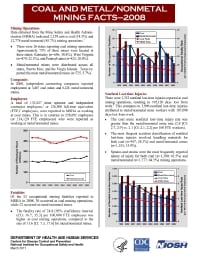Mining Publication: Coal and metal/nonmetal mining facts - 2008
Original creation date: March 2011
Authors: National Institute for Occupational Safety and Health
NIOSHTIC2 Number: 20039166
Pittsburgh, PA: U. S. Department of Health and Human Services, Public Health Service, Centers for Disease Control and Prevention, National Institute for Occupational Safety and Health, DHHS (NIOSH) Publication No. 2011-170, 2011 Mar; :1-2
Mining Operations: Data obtained from the Mine Safety and Health Administration (MSHA) indicated 2,129 active coal (14.3%) and 12,778 metal/nonmetal (85.7%) mining operations. 1. There were 26 states reporting coal mining operations. Approximately 73% of these mines were located in three states: Kentucky (n=656; 30.8%), West Virginia (n=479; 22.5%), and Pennsylvania (n=425; 20.0%). 2. Metal/nonmetal mines were distributed across all states, Puerto Rico, and the Virgin Islands. Texas reported the most metal/nonmetal mines (n=725, 5.7%). Companies: In 2008, independent contracting companies reported employment at 3,467 coal mines and 6,128 metal/nonmetal mines. Employees: A total of 133,827 mine operator and independent contractor employees, or 126,500 full-time equivalent (FTE) employees, were reported to MSHA as working at coal mines. This is in contrast to 258,892 employees (or 214,120 FTE employees) who were reported as working at metal/nonmetal mines. Fatalities: Of the 52 occupational mining fatalities reported to MSHA in 2008, 30 occurred at coal mining operations, while 22 occurred at metal/nonmetal mines. 1. The fatality rate of 24.8 [95% confidence interval (CI): 16.7, 35 .3] per 100,000 FTE employees was higher at coal mining operations, compared to the rate of 11 .6 [CI: 7.3, 17.6] for metal/nonmetal mines. Nonfatal Lost-time Injuries: There were 3,352 nonfatal lost-time injuries reported at coal mining operations, resulting in 195,120 days lost from work. This compares to 3,996 nonfatal lost-time injuries attributed to metal/nonmetal mine workers with 187,090 days lost from work. 1. The coal mine nonfatal lost-time injury rate was greater than the metal/nonmetal mine rate (2.8 [CI: 2.7, 2.9] vs. 2.1 [CI: 2.1, 2.2] per 100 FTE workers). 2. The most frequent accident classification of nonfatal lost-time injuries involved handling materials for both coal (n=947; 28.3%) and metal/nonmetal mines (n=1,353; 33.9%). 3. Sprains and strains were the most frequently reported nature of injury for both coal (n= 1,390; 41.5%) and metal/nonmetal (n=1,777; 44.5%) mining operations

NIOSHTIC2 Number: 20039166
Pittsburgh, PA: U. S. Department of Health and Human Services, Public Health Service, Centers for Disease Control and Prevention, National Institute for Occupational Safety and Health, DHHS (NIOSH) Publication No. 2011-170, 2011 Mar; :1-2
- Coal and Metal/Nonmetal Mining Facts - 2008 (HTML)
- Coal Contractor Mining Facts - 2001
- Coal Contractor Mining Facts - 2002
- Coal Contractor Mining Facts - 2003
- Coal Contractor Mining Facts - 2004
- Coal Contractor Mining Facts - 2005
- Coal Contractor Mining Facts - 2006
- Coal Contractor Mining Facts - 2007
- Mining Fact Sheets
- Rib Falls: A Major Ground Control Issue